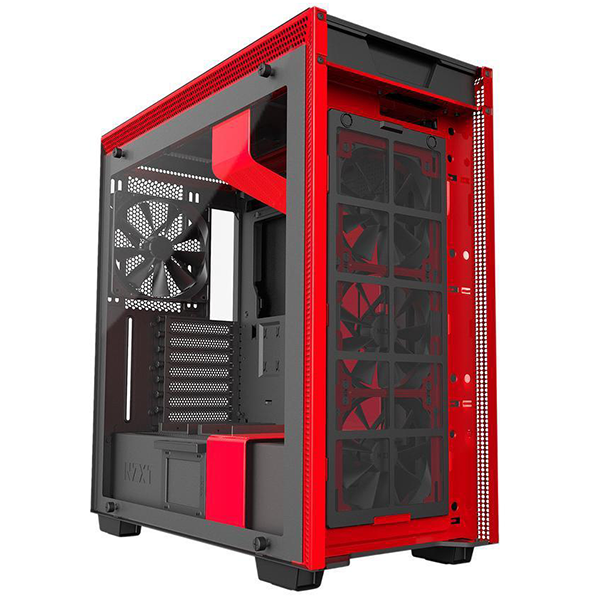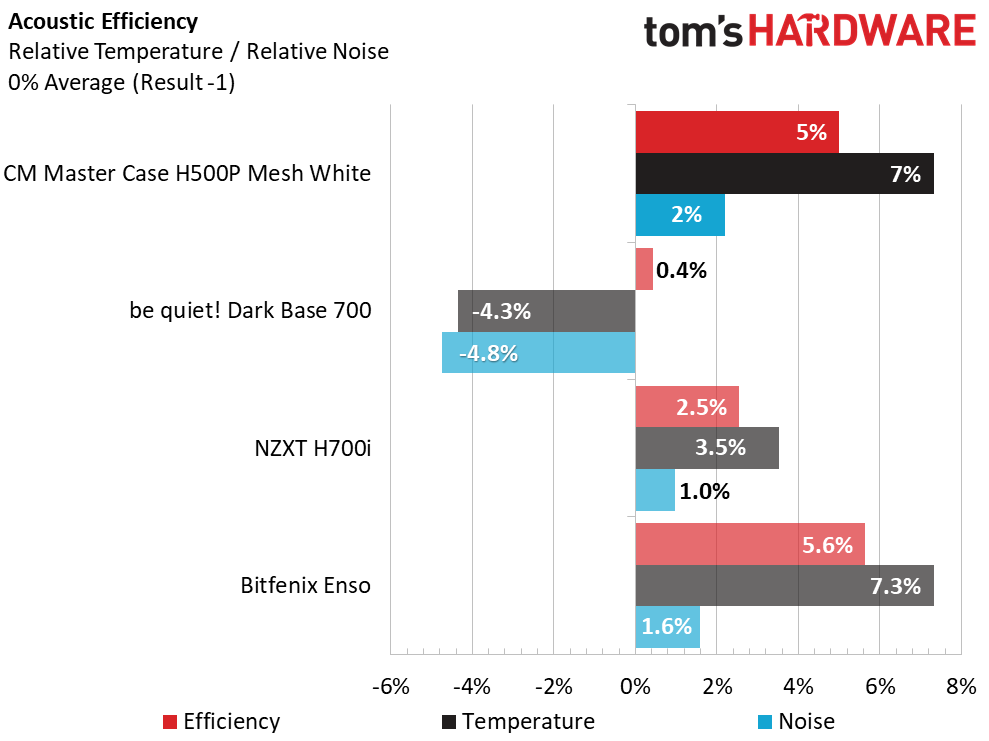Cooler Master MasterCase H500P Mesh White: Spiffy Looks, and Better Thermals
Why you can trust Tom's Hardware
Benchmark Results & Conclusion
For the purposes of comparison, we are using the NZXT H700i, the Bitfenix Enso, and the be quiet! Dark Base 700. The cases used for comparison are of similar sizes and feature sets, and all have tempered-glass side panels.
With the case's fans set at 1400 RPM, CPU core temperatures on our budget quad-core Core i5-7500 processor running at 3.8GHz were excellent. The Cooler Master MasterCase H500P Mesh performed head and shoulders above the competition, thanks in no small part to the massive airflow provided by the dual 200mm intake fans. Processor temps never exceeded 37°C over the ambient temperature of 25°C.
Graphics-card temperatures fared even better, with our test GPU barely hitting 45°C over the ambient. Regardless of how hard we pushed our test system, the H500P Mesh stayed as cool as a cucumber. Let's see if all this cooling performance has to come at a cost to acoustic performance.
Considering this chassis has two 200mm intake fans and a mesh front panel, we were expecting higher-than-average noise levels in our testing. At idle, this case performed well, generating just 31.4dBA. Sure, the thick glass side panel helps a bit by reflecting noise back into the chassis, but conventional wisdom tells us that a case with this feature set should produce noisier results than the 34.7dBA we saw under load. Color us impressed.
As a side note, when fan speed was set at 1400 RPM, we noted a distinct "whooshing" sound produced by this chassis, as air is drawn through the perforated front face.
We determine acoustic efficiency, also referred to as "cooling-to-noise ratio," by averaging all five of our tests to determine a base value.
Although looks are subjective, we feel that the H500P Mesh is very handsome as it ships from the factory. That said, this case is (literally) a blank canvas for simple mods such as a paint job, graphics stick-ons, and other cosmetic improvements that personalize your system. This chassis is also available in gunmetal grey.
Get Tom's Hardware's best news and in-depth reviews, straight to your inbox.
The fit and finish of this case are top-notch, and the overall construction is quite solid. Shoppers will have to decide whether these factors justify the $150 price. To our eyes, this chassis would be a much better value and a solid Editors' Choice award candidate were it in the $120 to $130 range.
Overall, the MasterCase H500P has great looks, excellent thermal performance, spiffy RGB lighting, a cleverly designed tempered-glass side panel, and a host of premium features. That said, those features come at slight premium. Also, though Cooler Master is hardly the only company guilty of this, we simply do not understand why most case manufacturers choose not to include at least one USB Type-C port on their cases in this price range.
MORE: Best Cases
MORE: All Case Content
Current page: Benchmark Results & Conclusion
Prev Page Hardware Installation & Test ConfigurationSteven Lynch is a contributor for Tom’s Hardware, primarily covering case reviews and news.
-
DRosencraft It's certainly one of the nicer looking cases on the market; a lot of cases on the market today seem to be just straight metal boxes, maybe with a glass door thrown on. I get the minimalist aesthetic, but it's nice to see a case balance that with a bit of flare. The price is slightly high, but not terribly so - only $20-$30 above cheaper comps isn't bad at all. As for the lack of the USB-C on the front panel... I don't know that it's all that important (which is why I guess it gets mentioned right at the end). I think a lot of case manufacturers got a little miffed, maybe slightly burned, that there was that big push to add USB 3.0 to their cases, and then it went highly underused. C has its uses, no doubt, but there aren't that many, and I don't know that other than maybe a few phone chargers there is a lot of adoption of anything that needs USB-C out there. In any event, given the mod-ability of the case, I would be surprised if one couldn't grab a USB-C header online and swap it in for one of the other USB panel connectors.Reply -
gosubuilder Reply20811039 said:It's certainly one of the nicer looking cases on the market; a lot of cases on the market today seem to be just straight metal boxes, maybe with a glass door thrown on. I get the minimalist aesthetic, but it's nice to see a case balance that with a bit of flare. The price is slightly high, but not terribly so - only $20-$30 above cheaper comps isn't bad at all. As for the lack of the USB-C on the front panel... I don't know that it's all that important (which is why I guess it gets mentioned right at the end). I think a lot of case manufacturers got a little miffed, maybe slightly burned, that there was that big push to add USB 3.0 to their cases, and then it went highly underused. C has its uses, no doubt, but there aren't that many, and I don't know that other than maybe a few phone chargers there is a lot of adoption of anything that needs USB-C out there. In any event, given the mod-ability of the case, I would be surprised if one couldn't grab a USB-C header online and swap it in for one of the other USB panel connectors.
I refuse to buy any cases that doesnt have a usb 3.0 in the front... -
mattkiss Reply20811448 said:I appreciate that there is a separate HDD/SSD activity light.
How can you tell? I didn't notice it mentioned anywhere in the article.
-
2Be_or_Not2Be Reply20812295 said:20811448 said:I appreciate that there is a separate HDD/SSD activity light.
How can you tell? I didn't notice it mentioned anywhere in the article.
It's on the close-up shot of the front/top panel with the ports. As least, that's what I assume it is based upon the single LED and the picture of "stacked discs" next to it.






